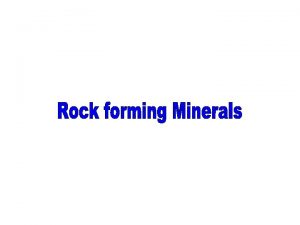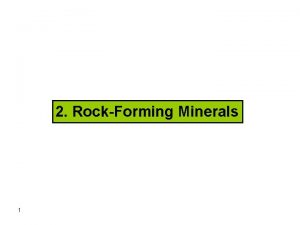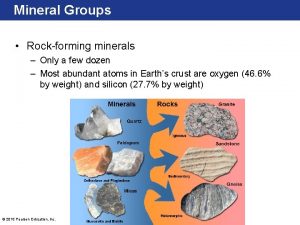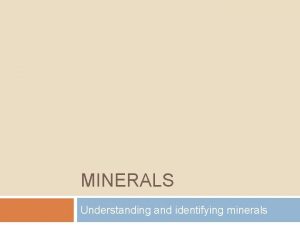Identifying Minerals RockForming Minerals Over 2000 known minerals






- Slides: 6

Identifying Minerals Rock-Forming Minerals Over 2000 known minerals, many are rare Common minerals are rock-forming minerals Most R-F minerals are silicate The minerals are identified by their physical properties The study of minerals is mineralogy

Identification by Inspection Colour is the first and most easily observed mineral property Colour is the least useful property, because many different minerals have similar colours Traces of impurities can turn colourless minerals into coloured minerals Luster is the way the mineral shines in reflected light Lusters are either metallic or nonmetallic Nonmetallic luster can be vitreous (like glass), pearly, resinous, or glassy. Diamond has adamantine luster. Other terms are greasy, oily, dull, and earthy

Identification by Tests The streak of a mineral is the colour of its powder, obtained by rubbing it on an unglazed white tile called a streak plate. The cleavage of a mineral is its tendency to split easily or separate along flat surfaces Some minerals tend to break along non-cleavage surfaces, called fracture http: //academic. brooklyn. cuny. edu/geology/grocha/mineral/cleavage. html The hardness of a mineral is its resistance to being scratched, diamond is the hardest, talc is the softest Friedrich Mohs devised the hardness scale from one to ten


Specific Gravity Specific gravity is the ratio of the weight of a mineral to the weight of an equal volume of water S-G tells you how many times as dense as water the mineral is Nearly all minerals are denser than water Their specific gravities are greater than 1 The weight of the mineral is found by weighing it in air Then the mineral is weighed underwater The second weighing indirectly gives the weight of an equal volume of water The sample weighs less underwater due to buoyancy Archimedes’ principle states that this loss in weight is equal to the weight of the displaced water Specific gravity = weight of sample in air weight of equal volume of water = weight of sample in air loss of weight in water

Acid Test Calcite is the principle mineral in limestone and marble Calcite is calcium carbonate, and a drop of weak hydrochloric acid will cause it to fizz. The bubbles are carbon dioxide gas











